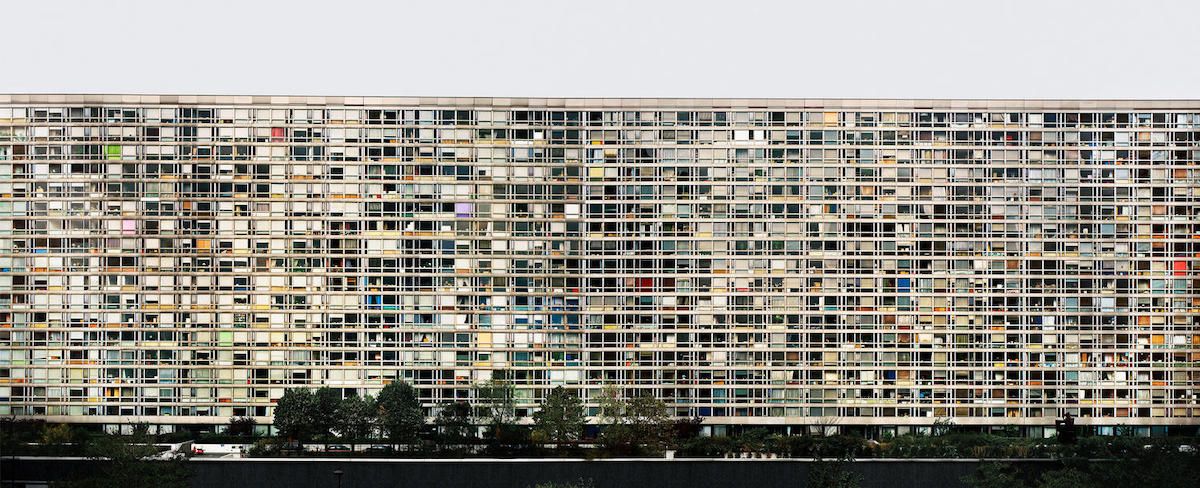
The exhibition Spectacular City. Photographing the Future at the Netherlands Architecture Institute claims to present the best works by 29 prominent photographers from the Netherlands and abroad. The photos on show are said to "represent the best examples of urban photography from the last ten years". Now I'm not sure whether all of these 29 photographers are prominent and I cannot judge whether the exhibition shows their best works, but an exhibition which does not include the Architecture of Density series by Michael Wolf and work by Edward Burtynsky and Robert Polidori cannot claim to "represent the best examples of urban photography from the last ten years". Perhaps we should not lay too much weight on whatever the exhibition sets out to be and simply look at what's on show. After all, the claims in the press release only serve the purpose of attracting visitors. On the other hand, the idea behind the exhibition does influence everything from the selection of works to the exhibition layout.
The exhibition includes aerial photos of Madrid by Vincenzo Castella, of Paris by Balthasar Burkhard, of Tokyo by Naoya Hatakeyama and of various cities in Asia by Taiji Matsue. Now the question is what the organizers of the exhibition want to show. Do they want to show aerial photos of different cities, in which case they could have taken some from any stock photography agency or do they want to show the work of four different photographers? The photos are largely interchangeable and can be processed and printed to look even more identical. As a matter of fact, this is what Taiji Matsue wants to show, that seen from above many cities look the same.
The exhibition also includes some night photographs of Düsseldorf taken by Thomas Ruff, not to be confused with Thomas Struth, whose work is also included in the show. There's nothing particularly interesting about these photos and I suspect that the exhibition organizers merely wanted to include some photos by Thomas Ruff, a famous artist/photographer, while at the same time showing a different aspect of the city (ordinary streets and houses at night) and a different kind of photography (night photography).
As I walked through the exhibition I was surprised to see some photos which closely resemble some of my own. According to the hand-out: "In Concrete, at first glance we see just the material of a building, but as we look more closely at the image, we recognize the relation between surface and mass. In this portrait of the Queen Elizabeth Hall, [Heidi] Specker denies the function of the building, leaving nothing of the architect's intention. Through a perceptive deconstruction, Specker focuses our attention on its graphic composition and material qualities." I've been taking extreme close-ups of buildings and walls for years and apparently so has Heidi Specker. I like the South Bank Center in London, as well as the Barbican Center, because of all the concrete buildings that I know, these are the most "concrete". When I read the curatorial blurb for Heidi Specker I realized that what I need to do is not take more photos, but write some captions that will appeal to curators or to get myself a good copywriter.
I quite like the work of Olivo Barbieri and I enjoyed seeing his photos printed at poster size. I do find his work rather limited though, as it relies on a technical innovation: the use of a tilt-shift lens to shoot with selective focus. As a result photos look like model worlds. The thing is, once you've seen Rome, Las Vegas and Shanghai in selective focus you've kind of seen the trick. Other photographers, such as Miklos Gaal and Frank van der Salm, have started using the same technique with the same results. If you can't afford a tilt-shift lens but would like to experiment with selective focus yourself, buy one of these lensbabies.
I must say that I quite like the work of Frank van der Salm, although he doesn't appear to let the locations he visits change his photography, and it's a shame the organizers didn't include more of his work. There are other great photos on show as well, by Francesco Jodice and Armin Linke, whose work is somewhat akin to mine and by Thomas Demand, whose photos look deceptively simple and familiar. On closer observation you notice that his scenes are all made of paper and cardboard and if you're very well informed you will notice that some are crime scenes. Also on show are some monumental photos by Andreas Gursky. In art photography size still matters.
You have to search hard to find people in the urban landscapes shown here. There are some in the photos of Armin Linke, but most photographers included in the exhibition appear to wait until those annoying people have moved before releasing the shutter.
The exhibition shows some great photos and if you want to see more, there are books by all photographers in the exhibition. I think I spend as much time browsing through these books as looking at the photos on show. As an exhibition of the city or of urban photography, Spectacular City falls short though. What is missing is the view from the street. But I must admit, aerial views are more spectacular.
Spectacular City. Photographing the Future is at the Netherlands Architecture Institute, Rotterdam until 7 January 2007.